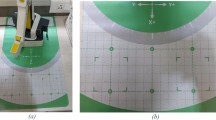Abstract
In this paper, we propose a novel method to control a robot without robot manipulation. Users do not need to precisely manipulate the robot and to learn the manipulation method. The proposed method can send commands to a robot by using a human action sequence that achieves their own task. In order to enable the robot to achieve tasks, we introduce a keep-based interaction in which a human keeps an action in the sequence for a certain period. The advantages of our method are efficiency improved by not requiring additional human actions, and functionality to enable a robot to perform further actions. We consider that the efficiency is supported by users’ physical workloads and cognitive loads. Users’ physical workloads would not be increased because the proposed method does not require additional human actions. However, the effect of the proposed method on users’ cognitive loads is unknown. We applied the method to a desktop sweeping task by a human and a small mobile robot, and conducted an experiment with participants to measure users’ cognitive loads in a cooperative sweeping task. As a result, we found that the proposed method had a lower cognitive load than a typical conventional method.
Similar content being viewed by others
References
United Nations Economic Commission for Europe, International Federation of Robotics (2004) World robotics 2004—statistics, market analysis, forecasts, case studies and profitability of robot investment. Palais des Nations
Hayashibara Y, Sonoda Y, Takubo T, Arai H, Tanie K (1999) Assist system for carrying a long object with a human—analysis of a human cooperative behavior in the vertical direction. In: Proc of 1999 IEEE/RSJ international conference on intelligent robots and systems
Arai H, Takubo T, Hayashibara Y, Tanie K (2000) Human-robot cooperative manipulation using a virtual nonholonomic constraint. In: Proc of 2000 IEEE international conference on robotics and automation
Nakai K, Kosuge K, Hirata Y (2002) Control of robot in singular configurations for human-robot coordination. In: Proc of IEEE int workshop on robot and human interactive communication, pp 356–361
Yokoyama K, Maeda J, Isozumi T, Kaneko K (2001) Application of humanoid robots for cooperative tasks in the outdoors. In: Proc of IEEE/RSJ IROS workshop on explorations towards humanoid robot applications
Yokoyama K, Handa H, Isozumi T, Fukase Y, Kaneko K, Kanehiro F, Kawai Y, Tomita F, Hirukawa H (2003) Cooperative works by a human and a humanoid robot. In: Proc of the 2003 IEEE international conference on robotics and automation, pp 2985–2991
Triesch J, von der Malsburg C (1997) Robotic gesture recognition. In: Proc of the Bielefeld gesture workshop, pp 233–244
Waldherr S, Romero R, Thrun S (2000) A gesture based interface for human-robot interaction. Auton Robots 9(2):151–173
Marrone F, Strobel M (2001) Cleaningassistant—a service robot designed for cleaning tasks. In: Proc of advanced mechatronic systems
Breazeal C, Aryananda L (2002) Recognition of affective communicative intent in robot-directed speech. Auton Robots 12(1):83–104
Lauria S, Bugmann G, Kyriacou T, Klein E (2002) Mobile robot programming using natural language. Robot Auton Syst 38(3–4):171–181
Kajikawa S, Hiratsuka S, Ishihara T, Inooka H (2003) Robot position control via voice instruction including ambiguous expressions of degree. In: Proc of IEEE int workshop on robot and human interactive communication
Crandall JW, Goodrich MA (2002) Characterizing efficiency of human-robot interaction: A case study of shared-control teleoperation. In: Proc of IEEE/RSJ international conference on intelligent robots and systems
Katagami D, Yamada S (2003) Active teaching for an interactive learning robot. In: Proc IEEE workshop robot and human interactive communication
Khamis AM, Rodríguez FJ, Salichs MA (2003) Remote interaction with mobile robots. Auton Robots 15:3
Schwartz MF, Edwards ES, Montgomery M, Palmer C, Mayer NH (1991) The quantitative description of action disorganization after brain damage: a case study. Cogn Neuropsychol 8:381–414
Newtson D (1973) Attribution and the unit of perception of ongoing behavior. J Pers Soc Psychol 28(1):28–38
Newtson D, Engquist G (1976) The perceptual organization of ongoing behavior. J Exp Soc Psychol 12:436–450
Newtson D, Engquist G, Bois J (1977) The objective basis of behavior units. J Pers Soc Psychol 35(12):847–862
Choset H (2001) Coverage for robotics—a survey of recent results. Ann Math Artif Intell 31:113–126
Brooks RA (1986) A robust layered control system for a mobile robot. IEEE J Robot Autom 2(1):14–23
Condron JE, Hill KD (2002) Reliability and validity of a dual-task force platform assessment of balance performance: effect of age, balance impairment, and cognitive task. J Am Geriatr Soc 50:157–162
Strobel M, Illmann J, Kluge B, Marrone F (2002) Gesture recognition in a spatial context for commanding a domestic service robot. In: Proc of the 33rd international symposium on robotics
Terada K, Nishida T (2002) A method for human-artifact communication based on active affordance. In: AAAI’02 workshop on intelligent situation-aware media and presentations
Sato T, Nishida Y, Ichikawa J, Hatamura Y, Mizoguchi H (1994) Active understanding of human intention by a robot through monitoring of human behavior. In: Proc 1994 IEEE/RSJ international conference on intelligent robots and systems, pp 405–414
Kuniyoshi Y, Inaba M, Inoue H (1994) Learning by watching: extracting reusable task knowledge from visual observation of human performance. IEEE Trans Robot Autom 10(6):799–822
Nicolescu M, Mataric M (2001) Learning and interacting in human-robot domains. IEEE Trans Syst Man Cybern, Part A 31(5):419–430
Zhao S, Nakamura K, Ishii K, Igarashi T (2009) Magic cards: a paper tag interface for implicit robot control. In: Proc CHI ’09. ACM Press, New York, pp 173–182
Kemp C, Anderson C, Nguyen H, Trevor A, Xu Z (2008) A point-and-click interface for the real world: laser designation of objects for mobile manipulation. In: Proc HRI ’08. ACM Press, New York, pp 241–248
Author information
Authors and Affiliations
Corresponding author
Rights and permissions
About this article
Cite this article
Kobayashi, K., Yamada, S. Extending Commands Embedded in Actions for Human-Robot Cooperative Tasks. Int J of Soc Robotics 2, 159–173 (2010). https://doi.org/10.1007/s12369-010-0054-y
Accepted:
Published:
Issue Date:
DOI: https://doi.org/10.1007/s12369-010-0054-y




